Cord-Cutter Gear: Three Antennas and a Pre-amp
The tried-and-true bowtie antenna under test. Note the high-tech antenna mount.
The HD Quad under test.
The CC Aerowave under test.
Channel Master’s StealthTenna 50 under test. The performance of each antenna was verified with an AVCOM spectrum analyzer, Hauppauge Aero-M USB stick receiver, and TS Reader software.

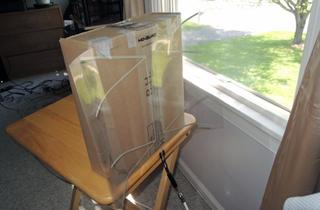

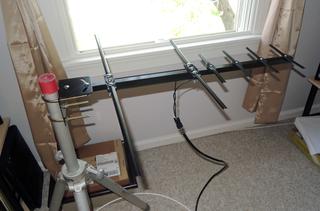

DOYLESTOWN, PA.—The cord-cutting landscape has changed considerably in the past 12 months, and it’s no longer a fad, but a growing trend as more and more consumers decide that they can get by just fine without expensive pay TV channel packages.
In fact, Comcast reported recently that they now have more subscribers for broadband service than for pay TV channels, which accords greater importance to Comcast’s failure to acquire Time Warner: The combined companies would have controlled broadband distribution to a disproportionate number of U.S. homes.
While Internet service is the key part of cord-cutting, free over-the-air television still pays an important part. Think of the Super Bowl, the NHL Stanley Cup and NBA championships, and the NCAA Final Four championship game.
But there’s also a lot of good programming on free TV right now. In recent months, my wife and I have used our Channel Master DVR+ and TiVo HD to time-shift and watch “The Blacklist, ” “American Crime,” “Brooklyn 9-9,” “The Good Wife,” “60 Minutes,” “American Odyssey,” “CSI,” “Blackish,” “Saturday Night Live,” and “Mr. Selfridge” (plus a host of one-time PBS programs).
Throw in some Netflix streaming (House of Cards) and there’s plenty to watch without Big Cable. So a balanced cord-cutting approach should incorporate both broadband and terrestrial broadcast TV.
To get the former, you need a fast Internet connection and a late-model Wi-Fi router. To get the latter, you only need some sort of antenna to connect to your television or receiver/DVR, like the Channel Master box, TiVo’s Roamio, Tablo, or Mohu’s new Channels product.
Get the TV Tech Newsletter
The professional video industry's #1 source for news, trends and product and tech information. Sign up below.
Blessed with a few days of nice weather, I decided to excavate my pile of review products and found three antennas patiently waiting for testing. The first was a rather odd-looking design from HD Frequency, called the CC Aerowave ($49 with 12-foot cable from www.hdfrequency.com). It resembles a small window with a 75-ohm coaxial balun attached to the inner corners of two panes.
The second antenna came all the way from Australia and goes by the name HD Quad ($39.99 from www.hd-quad.com). It’s a flexible, transparent antenna with UHF collinear elements, not unlike many other antennas I’ve tested.
The last antenna is a bit larger and is a six-element VHF/UHF yagi, and comes from Channel Master. The StealthTenna 50 (CM3010HD, $29.00 from www.channelmaster.com) can be mounted indoors or outdoors. It’s small enough to sit in a closet or attic space, or even in a room – think of it as functional art.
I also found a new inline signal preamplifier from Antennas Direct. The Juice UHF/VHF Amplifier ($79.99 from www.antennasdirect.com) can be used inside or outside and provides about 18 dB of signal boost with a low noise figure, which is real handy in areas where TV reception can be problematic. (Successful digital TV reception is all about signal-to-noise ratio!)
THE SET-UP
For this round of testing, I dusted off my tried-and-true UHF bowtie antenna, once available from Radio Shack but largely ignored by retailers today. (Seriously – how many of them want to sell a $5 TV product?)
I set the bowtie up on a folding table in my home office and attached it to a large cardboard box with masking tape. While that part of the test was decidedly low-tech, I then connected the antenna lead into a two-way splitter, with one leg going to a spectrum analyzer and the other going to a Hauppauge Aero-M USB tuner, connected to my Toshiba laptop.
This arrangement allowed me to see the actual waveform and signal strength of each TV station under test. I could then verify successful reception with the Aero-M, and to close the deal, look at the actual MPEG-2 video stream from each station using TS Reader. These three measurements gave me a very concise report on the performance of each antenna.
If you go back to my last round of testing in November of 2014, you’ll see that I used the same antenna position (different box, though!) and same test gear. The only possible differences in testing would come from the amount of foliage on nearby trees, as my house is partially blocked from the Philadelphia/Roxborough antenna towers over a20+ mile path. (In other words, an ideal site for indoor TV antenna testing!)
The Philadelphia TV market is unique in that it has two high-power, low-band VHF TV stations – KJWP (Independent) on channel 2, and WPVI (ABC) on channel 6. There are only 40 or so low-band DTVs in operation nowadays as that part of the RF spectrum is susceptible to impulse noise and strange propagation enhancement. Antennas that work well from channels 2 through 6 (about 54 to 88 MHz) are also very large – a half-wavelength dipole for channel 6 needs to be about 68 inches long!
There’s also one high-band VHF operation on channel 12, WHYY (PBS). The rest of the Philly DTV stations are active on the UHF band, starting at channel 17 (WPHL) and ending at channel 42 (WTXF (Fox)). In addition, I can easily pick up three DTV stations from the Allentown area: WBPH-9, WLVT-39 (PBS), and WFMZ-46 (Independent). There’s even a repeater for WTXF on channel 38 that shows up on my home antenna array, plus WNJT-43 in Trenton.
Table 1. Here’s how each antenna performed with 11 VHF/UHF test channels. THE TESTS I picked a handful of stations to verify reception: WPVI-6, WBPH-9, WHYY-12, WPHL-17, KYW-26 (CBS), WUVP-29 (Univision), WCAU-34 (NBC), WYBE-35 (Independent), WLVT-39, WTXF-42, and WFMZ-46. Any of these antennas would be doing an outstanding job if they grabbed all of these stations, as their signal levels vary widely and there’s about 113 degrees directional offset between the Roxborough and Allentown antenna towers.

The first measurements were made with the bowtie, but unamplified and with the Juice amplifier connected. I then repeated these measurements with the HD Quad, CC Aerowave, and StealthTenna 50; again, unamplified and amplified. (I’ll have separate comments at the end of this article on the performance of the Juice amplifier.)
Perhaps the toughest signal to pull in is WPVI on channel 6. Two of the review antennas aren’t really designed for low-band VHF reception, but WPVI runs quite a bit of power and manages to get picked up by brute force on many antennas. (None of the test antennas could pull in KJWP-2 reliably). The rest of the stations aren’t quite as challenging to pull in.
< Table 2. And here’s how each antenna/amplifier combination ranked after the tests. Table 1 shows the results of my tests. Amplifiers do make a big difference, and helped the lowly bowtie antenna and StealthTenna 50 capture first place with 9 out of 11 stations received reliably (i.e. no drop-outs for at least a full minute). To be fair, the StealthTenna 50 is a much larger, directional antenna than the CC Aerowave and HD Quad, both of which should behave like dipoles with classic figure-8 patterns.

Table 2 ranks the antennas by performance. The bowtie by itself wound up in a three-way tie for second place with the amplified HD Quad and bare-bones StealthTenna 50, grabbing 8 out of 11 signals. Following behind was the amplified CC Aerowave, having received 7 out of 11 stations successfully and the bare-bones HD Quad with 6 out of 11 stations.
The Aerowave was a puzzler. By itself, it only received one station – WFMZ on channel 46. I experimented with laying it flat and orienting it at right-angles to the Roxborough antenna farm to try and improve reception, and oddly enough, both of these alignments were more successful than simply positioning the antenna with its face in the correct compass heading. Lying flat, it picked up 4 of 11 stations successfully, while angled at 90 degrees, it grabbed 6 of 11.
The literature supplied with the Aerowave says you can “position the antenna in any desired location,” but based on my results, you may be futzing with it for a while to get the best reception – something I didn’t have any problems with when using the Mohu Leaf, Ultimate, and Winegard FlatWave antennas last November.
Just how much difference does an amplifier make? Here’s a view of channel 2 through 6, as received by the bowtie antenna, unamplified. WPVI’s signal on channel 6 is at the center of the screen. And here’s the spectral view with the Juice amplifier inline. You can actually see KJWP’s signal on channel 2 now (far left). ADDING SOME JUICE
In my tests, the Juice boosted WPVI’s signal on channel 6 by about 15 dB and raised the noise floor from about -87 dBm to -85 dBm – or 2 dB, as the specifications claim. All amplifiers generate noise, and a good design will keep that to a minimum to avoid spurious signals and interference to desired signals. (Cheap amplifiers won’t!) Performance was comparable on channels 9, 12, and even 17, where I saw signal levels increase by about 18 dB.

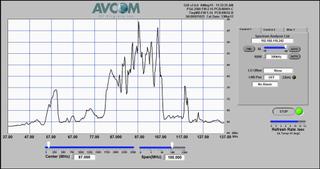
At the high end of the UHF band, I saw an improvement of 20 dB with an increase in noise figure of about 2.5 dB, using WFMZ’s powerful signal on channel 46 for testing. That’s excellent performance for a UHF amplifier and rivals that of the
Channel Master Titan-series mast-mounted amplifiers I’ve been using for years. (Titan 2 VHF/UHF 16 dB $65.00, Titan 2 VHF/UHF 30 dB $69, both available from www.channelmaster.com)
I don’t have any data on the Juice’s resistance to intermodulation signal distortion (or overloading from very strong in-band and adjacent-band signals), other than to say that the dozens of very strong FM radio carriers that also broadcast from Roxborough didn’t create any reception issues for me with channel 6 when the amplifier was inline.
Here’s a spectral view of WBPH-9 and WHYY-12 with no amplification… And here are both channels after turning on “the Juice.” Here is a view of the UHF TV spectrum from channel 17 to channel 46, as received by the Aerowave with the Juice amplifier. (I could only pick up one signal without amplification.) Many of the TV signal waveforms are quite distorted, which makes the job of the adaptive equalizers that much harder.
Here’s the same view of the UHF TV spectrum, this time received by the HD Quad equipped with the Juice amplifier. Note that the TV signal waveforms are somewhat cleaner with less multipath distortion.
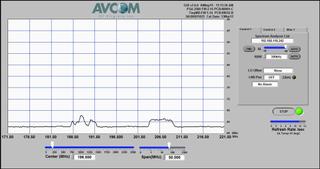

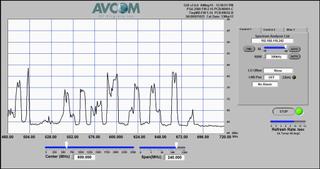
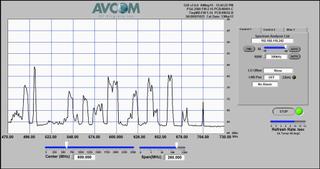
One more look at the UHF TV spectrum, this time through the elements on Channel Master’s StealthTenna 50 and Juice amplifier. Most received channels are very clean with little multipath distortion. Finally, the same UHF TV spectrum, this time as received by the lowly bowtie, again with “Juice.” Amazing how well such a simple antenna works, isn’t it? That big spike on the far right is WFMZ-46, whose operating frequency is close to resonance with the half-wave loop created by the bowtie antenna. Hence, the very strong signal. (At one time, channel 46 was near the middle of the UHF band, believe it or not!)


CONCLUSIONS
It is amazing how little antenna you need to achieve indoor TV reception. My location is sub-optimal in this regard, given my distance to Roxborough and the number of obstructions in my path.
Yet, with just a $5 bowtie antenna, I was able to receive eight TV stations reliably (5 from Philadelphia and 3 from Allentown), including all major networks (CBS, NBC, ABC, Fox, and PBS). Adding the Juice amplifier brought in one more station, and probably fiddling with the bowtie position would have captured the remaining two on my list.
Channel Master’s StealthTenna 50 isn’t exactly small, but you can put it in tight locations indoors for reception, such as a townhouse attic. You can even install it on top of a shelf, or in a closet, and with an amplifier, it will do an excellent job – just use one of the many TV reception Web sites (TVFool.com is the best) to determine the compass heading and where to aim your antenna.
The HD Quad behaves like many other collinear antenna designs I’ve tested. It’s transparent, so you can hang it in a window, and it is a better performer on UHF channels than on VHF. Add an amplifier to it and you may grab a few more channels. One bonus – you can roll it up and take it with you on trips, as I often do. Hook it up to a USB tuner stick and you can watch local HDTV on your computer in hotel rooms.
The CC Aerowave was, to put it mildly, a disappointment. I even tried moving it to different locations, using the spectrum analyzer to peak the signal and see if I could improve those reception numbers. No dice! Some signals that wouldn’t come in at all were now just intermittent with frequent dropouts and frozen images. Adding the Juice amplifier didn’t help much, so I can’t recommend this antenna.
Finally, Antennas Direct’s Juice amplifier is a solid performer and delivers the goods. A noise figure approaching 2 dB in the UHF TV band is excellent performance for the price. There is a puzzler, though – although this amplifier is obviously weatherized, it doesn’t come with a mounting bracket for installation on a mast, which is the best place to out it to overcome signal loss and noise in the antenna downlead. Something for the AD folks to figure out…
